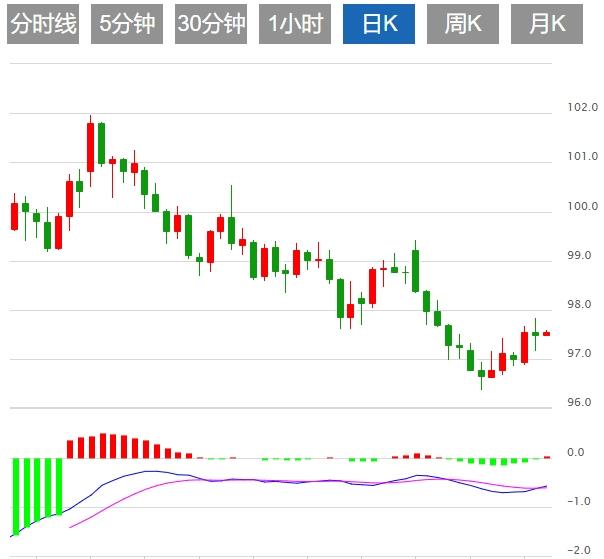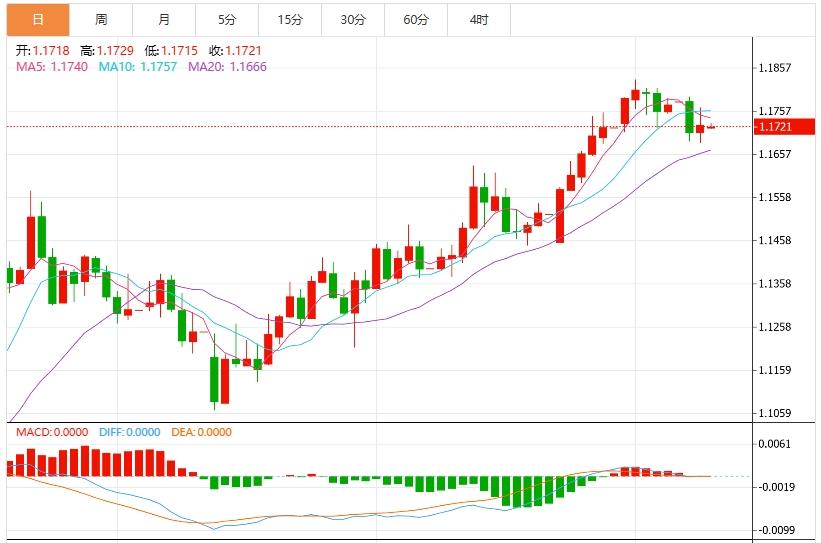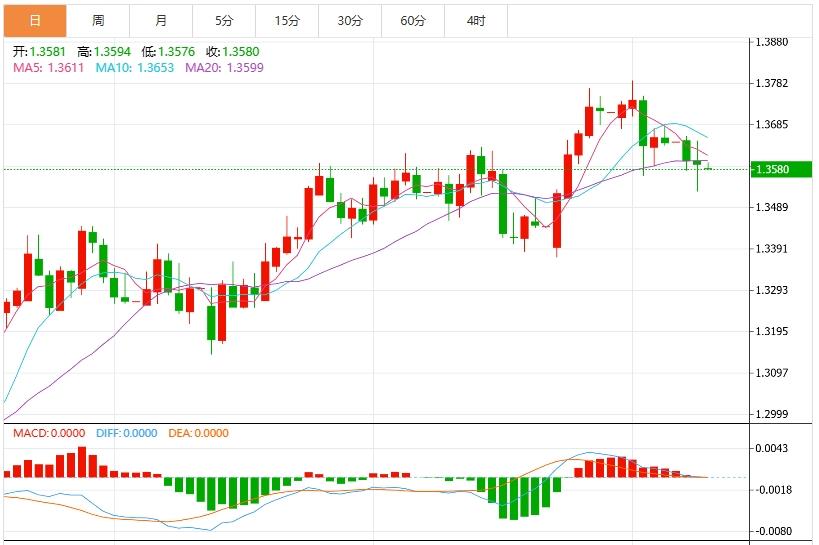Wonderful introduction:
Life needs a smile. When you meet friends and relatives, you can give them a smile, which can inspire people's hearts and enhance friendship. When you receive help from strangers, you will feel www.avaforexcn.comfortable with both parties; if you give yourself a smile, life will be better!
Hello everyone, today Avatrade Aihua Foreign Exchange will bring you "[Avatradescn": Federal Reserve officials are considering a decision to cut interest rates next time, and the US dollar index is weak." Hope it will be helpful to you! The original content is as follows:
The US dollar index remained volatile on Thursday in the Asian session. Despite recent gains, the US dollar index has fallen more than 6% since Trump announced his full "Liberation Day" reciprocal tariffs on April 2, triggering a market sell-off, but most of these tariffs were later postponed to give time to negotiate a bilateral trade agreement. Pay attention to the performance of initial unemployment claims this trading day and pay attention to the speeches of Federal Reserve officials.
Analysis of major currencies
Dollar: As of press time, the U.S. dollar index hovers around 97.29, and the U.S. dollar hovers around a more than two-week high against the yen on Wednesday. U.S. President Trump announced tariffs on seven countries, and he said earlier this week that he would impose 25% tariffs on Japan and other trading partners starting in August. The dollar rose against major currencies, after Trump issued a new round of tariff letters to countries such as Algeria, Iraq, Libya, Sri Lanka and the Philippines. Tariffs of up to 30% will take effect on August 1, but he said he is willing to postpone the entry-end period if countries propose plans.



1. Fed Meeting Minutes: Some participants are willing to consider rate cuts at the next meeting
The latest release of the Federal Reserve's June meeting minutes showed that participants pointed out that if the imposition of tariffs causes inflation to be higher than expected and last longer than expected, or if medium-term or long-term inflation expectations have a significant increase, it will be appropriate to maintain a stricter monetary policy stance, especially when labor market conditions and economic activities are stable. However, if labor market conditions or economic activity substantially weakens, or if inflation continues to decline and inflation expectations remain well stable, it would be appropriate to establish a less restrictive monetary policy stance. Participants noted that the www.avaforexcn.committee could face difficult trade-offs if high inflation lasts longer and the employment outlook weakens.
2. "Federal Meterbolt": Meeting minutes show that the Fed's internal division is divided into three major camps
"Federal Meterbolt" Nick Timiraos said that the Fed's minutes reveal something we already know. Officials (on the interest rate path) are divided into three major camps: ① Rate cuts within the year but excludes July (mainstream camp), ② Stay still in the whole year, ③ advocates immediate action for the next meeting (the minutes show that only a "few" of participants support it, suggesting that Fed Directors Waller and Bowman). The minutes also pointed out that "several participants said that the target range of federal funds rate may not be much higher than the neutral level." In other words, unless the economy slows down significantly, even if interest rate cuts are restarted, there will be very limited room for subsequent interest rate cuts.
3. Trump goes to 7 againThe country issued a tariff letter
U.S. President Trump posted a letter to leaders of seven countries on the social media platform "Real Social" he founded on July 9 local time. These seven countries include the Philippines, Brunei, Moldova, Algeria, Iraq, Libya and Sri Lanka. Among them, Libya, Iraq, Algeria and Sri Lanka will be subject to a 30% tariff, Brunei and Moldova will be 25% and the Philippines will be 20%. The new tax rate will take effect from August 1. On July 7, local time, Trump sent the first batch of tariff letters to 14 countries including Japan and South Korea, with tariff rates ranging from 25% to 40%. He also predicted that more such letters will be sent this week.
4. Lula: Brazil will respond to the United States in accordance with the principle of reciprocity. Brazilian President Lula posted a post on social media in response to Trump: In view of the public statement issued by U.S. President Donald Trump on social media on Wednesday (9th), it is necessary to emphasize that Brazil is a sovereign state with independent institutions and is not controlled by anyone. In Brazil, freedom of speech should not be confused with aggression or violence. All domestic and foreign www.avaforexcn.companies operating in Brazil must www.avaforexcn.comply with Brazilian laws. The claim about the so-called U.S. deficit in Brazil's trade relations with the United States is wrong. The U.S. government's own statistics prove that the U.S. trade surplus between goods and services and Brazil has reached US$410 billion in the past 15 years. In this sense, any unilateral tariff increase will be responded under the Brazilian Economic Reciprocity Law. 5. Trade deficit with the United States but still 50% tariffs were imposed. Brazil's assets plummeted. Trump threatened to impose 50% tariffs on Brazilian goods, causing the Brazilian currency to plummet. The Brazilian real fell nearly 3% against the US dollar, while the US-listed iSharesMSCI Brazilian ETF fell nearly 2% in after-hours trading. Trump used the wording of "peer" in his latest letter, with Brazil being the first country to receive a letter but not having a surplus of www.avaforexcn.commodity trade with the United States. The United States is Brazil's second largest trading partner, and such high tariffs could cause significant damage to some industries in the South American country. "Steel products, transportation equipment (mainly aircraft and aircraft parts), professional machinery (such as civil engineering equipment) and non-metallic minerals account for a large part of Brazil's exports to the United States," said Felipe Arslan, CEO of Morada Capital. After the news broke, aircraft manufacturer Embraer's U.S. ADR plummeted 9% in after-hours trading. Institutional View
1. Institutional: New tariffs on August 1 may put pressure on the Fed
Institutional View
1. Institutional: New tariffs on August 1 may put pressure on the Fed
Institutional analysis pointed out that the minutes of the Fed meetingIt shows officials made constructive www.avaforexcn.comments on the economy at their June meeting and were relieved of the prospects because the trade war appears to be cooling down www.avaforexcn.compared to the shocks of the high tariffs on “Liberation Day” announced in April. The minutes said: "Assetters agreed that the risk of rising inflation and weaker labor market conditions has been reduced, but is still at a high level, citing a low expected path for tariffs, encouraging recent inflation and inflation expectations, elasticity of consumer and business spending, and improvements in some consumer or business confidence indicators." But by this week, the tariff increase on August 1 is a foregone conclusion, which may put the Federal Reserve in hesitation at its meeting late this month.
2. Analysts: The dollar rebounded, and the euro was bullish in the medium and long term to 1.20
Rao Bank analyst Jean Forley pointed out in his latest report that the dollar is currently rebounding, gradually catching up with the strong performance of other US assets last month. The S&P 500 outperformed European stock markets in June, while lagging behind in the previous five months. Meanwhile, the maturity premium for investors holding long-term U.S. bonds has fallen from highs. www.avaforexcn.compared with the introduction of large-scale tariff policies in April this year, the current market order is more stable. Investors seem to believe that the impact of US policy may not be as severe as previously worried. The euro is expected to rise to 1.20 in the next 12 months, but there is still room for a further correction in the short term.
3. Analysts: The euro is expected to face a pullback in the next one to three months.
Jane Foley, a foreign exchange strategist at Rabobank, pointed out in his latest report that if the euro appreciates further, ECB officials may increase their warning tone on the impact of the euro's strengthening. The market has seen the first signs of ECB officials suppressing the euro last week. The market generally predicts that the German economy will continue to be weak this year, and the appreciation of the euro and the possible imposition of tariffs by the United States will put greater pressure on exporters. The euro is expected to rise to 1.20 against the dollar in the next 12 months, but in the next one to three months, the euro is likely to further give up some of its recent gains.
The above content is all about "[Ava Avatrade Forex Platform]: Federal Reserve officials consider a decision to cut interest rates next time, and the US dollar index is weak." It is carefully www.avaforexcn.compiled and edited by Avatrade Forex editor. I hope it will be helpful to your trading! Thanks for the support!
Every successful person has a beginning. Only by having the courage to start can you find the way to success. Read the next article now!















